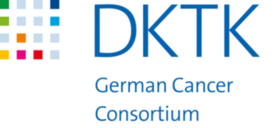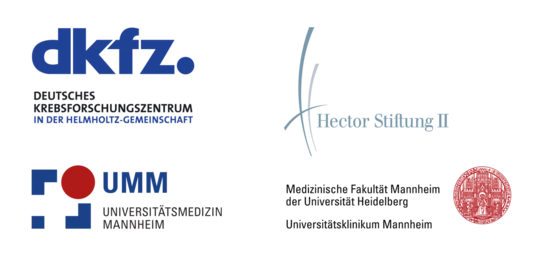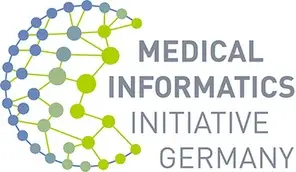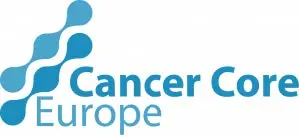Projects and Networks
We build bridges between institutions with GDPR-compliant federated data management solutions, including the ‘Mainzelliste’ for pseudonymisation and data record linkage, several federated search solutions and the ‘bridgehead’ for controlled data exchange.
- Clinical Communication Platform (DKTK)
- DKFZ-Hector Cancer Institute at the University Medical Centre Mannheim
- Helmholtz Institute for Translational Oncology Mainz
- Medical Informatics Initiative
- National Network Genomic Medicine Lung Cancer
- Onko Forschungs Datenzentrum
- BBMRI-ERIC
- Cancer Core Europe
- EUCAIM
- Hopp-ITCC International Data Integration Platform
Clinical Communication Platform (DKTK)

Within the German Cancer Consortium (DKTK), cancer researchers and physicians collaborate closely at eight locations across Germany to speed up the transfer to clinical practice of successful cancer research.
The Clinical Communication Platform (CCP-IT) is at the core of the German Cancer Consortium’s data management. Its federated infrastructure allows biosamples with associated patient data and research data to be merged in pseudonymised form. This provides comprehensive information for current and future research projects. The CCP also offers project support for clinical researchers and DKTK Joint Funding projects to promote the secondary use of both data and biosamples.
DKFZ-Hector Cancer Institute at the University Medical Centre Mannheim

The aim of the DKFZ-Hector Cancer Institute at the University Medical Centre Mannheim is to accelerate the transfer of results from cutting-edge oncological research into patient care (translation) and to make the use of findings from everyday clinical practice available for cancer research (reverse translation) by pooling expertise in the field of cancer research and cancer medicine. The Institute’s central Data Platform bridges the gap between research and clinical care by combining research data from study patients with data from clinical routine care, via a link to the Mannheim MII/NUM Data Integration Center (TransFAIR) and necessary groundwork such as pseudonymization (Mainzelliste), based on a common medico-legal framework.
Helmholtz Institute for Translational Oncology Mainz

The Helmholtz Institute for Translational Oncology Mainz (HI-TRON Mainz) has been established as a world-leading centre for personalised cancer medicine with a focus on immunotherapy. The HI-TRON Mainz Data Portal supports sustainable data management among all HI-TRON projects and PIs. Its data catalogue (based on Molgenis with a heavily customized user interface) contains common metadata collected from projects and core facilities to give researchers an overview of potentially reusable data and biosamples.
The portal allows scientists to search for expression profiles or molecular signatures in other study and tumour entities, for example. It also enables cross-OMIC integrations to develop multidimensional classifiers using machine learning
Medical Informatics Initiative

The medical informatics initiative was created to close the gap between research and healthcare. All of Germany’s university hospitals have joined forces with research institutions, businesses, health insurers, and patient advocacy groups to create a framework that harnesses research findings to the direct benefit of patients. Our “bridge departments” are involved in three projects of the Medical Informatics Initiative:
In the HiGHmed consortium, which combines and integrates the expertise of 12 leading university hospitals in Germany as well as other partners from science and industry, we have adopted our technology into a federated search for cancer patients with similar characteristics (Suche nach ähnlichen Patienten, SNAP). Secondly, we have pioneered a new algorithm for distributed record linkage via sensitive identifying information using Secure Multi Party Computation (SMPC). This will allow data linkage across sites and their datasets previously impossible due to the sensitivity of data (varying patient consents) while at the same time improving the protection of proband’s personal data.
In PM4Onco (Personalized Medicine for Oncology), we have developed a methodology for specifying plausibility rules in a uniform and standardised way to ensure data integrity and consistency within the oncological data. We have also demonstrated how plausibility checks can be systematically generated from groups of logical fields. In the area of interoperability and development of data specifications, we are coordinating the specification of the oncology module of the MII core dataset.
PrivateAIM (Privacy-preserving Analytics in Medicine) attempts to pave a balanced path between data protection and data use by developing privacy-centric federated analysis tools for the German national medical informatics infrastructure. It follows the principle of 'code to the data', in which the health data remain in the protected environments of the university hospitals and only the analysis algorithms are exchanged. This form of decentralized analysis ensures that data never leaves its secure environment. Patients' identities and sensitive health information thus remain fully protected and cannot be viewed by researchers at any time. To achieve this goal, the PrivateAIM project is dedicated to developing customized AI methods, risk models and federation mechanisms. These innovations are incorporated into the newly developed software platform FLAME (Federated Learning and Analysis in Medicine) and thus form the technological core for secure, distributed evaluations in the Medical Informatics Initiative (MII).
National Network Genomic Medicine Lung Cancer

The National Network Genomic Medicine Lung Cancer (nNGM) provides molecular diagnostics and innovative therapies to patients with advanced lung cancer all across Germany. Funded by the German Cancer Aid, 28 university cancer centres work together with more than 490 hospitals and physicians – including all centres of the German Cancer Consortium (DKTK) and all oncological centres of excellence. The basis for the distributed data exchange is the secure networking of the Clinical Communication Platform (CCP-IT) bridgeheads. Thanks to its expansion via the Connecting Comprehensive Cancer Centres (C4) initiative, this platform also includes all nNGM centres.
Onko Forschungs Datenzentrum

OnkoFDZ aims to combine data from clinical cancer registries (KKR), certified centers of the German Cancer Society, oncological excellence centers and statutory health insurance providers. Subsequently, AI methods such as machine learning will be used to capture the use and effectiveness of various therapies and to make the results of the analyses conducted usable for target groups, treatment providers and the public. We are responsible for record linkage and the data protection concept.
BBMRI-ERIC

BBMRI-ERIC (Biobanking and Biomolecular Resources Research Infrastructure – European Research Infrastructure Consortium) is Europe’s infrastructure for networked biobanking. Funded by 23 member states and organisatuions, BBMRI-ERIC facilitates access to both biosamples and biomolecular resources in biobanks all across the continent using inter alia the Locator, a federated search platform built on the Bridgehead technology. On a national level, we are responsible for IT developments within the German Biobank Node, the German representation to BBMRI-ERIC.
Cancer Core Europe

Cancer Core Europe is a consortium of seven leading cancer centres from Europe to accelerate the development of innovative cancer therapies through close collaboration in translational and clinical research. One of the four main pillars is the VDC (Virtual Data Centre), making this vision possible through data sharing. Based on the Bridgehead and our medico-legal data protection concept, CCE centers are establishing a federated data platform along with the Cancer Core Europe Data Portal, giving an overview of potentially available data across all European partners.
EUCAIM

The European Cancer Imaging Initiative (EUCAIM) connects research institutions, healthcare providers and commercial innovators from currently 12 countries across Europe to establish a unified European infrastructure for Cancer Imaging Research. EUCAIM provides an interoperable, privacy-compliant and secure infrastructure for conducting federated, distributed analysis of annotated, anonymised cancer imaging data. We are developing EUCAIM's federated exploration system based on Samply.Lens and Samply.Beam.
Hopp-ITCC International Data Integration Platform

The ITCC paediatric cancer data portal initiative establishes a sustainable solution for the systematic prioritisation of new cancer therapies for children in Europe and worldwide by making better use of existing molecular and clinical data, thus offering new hope to children with previously incurable cancers. We are responsible for metadata harmonisation and data linkage within the ITCC Data Platform, facilitating future development of cancer drugs for children and adolescents with cancer.